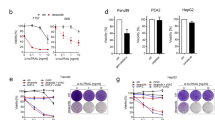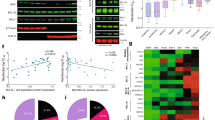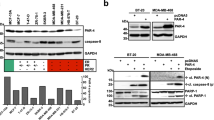Abstract
The death ligand TRAIL synergizes with DNA-damaging therapies such as chemotherapeutic drugs or ionizing irradiation. Here, we show that the synergism of TRAIL and 5-fluorouracil (5-FU) and cross-sensitization between TRAIL and 5-FU for induction of apoptosis, entirely depend on Bax proficiency in human DU145 and HCT116 carcinoma cells. DU145 prostate carcinoma cells that have lost Bax protein expression due to mutation fail to release cytochrome c and to activate caspase-3 and -9 when exposed to TRAIL and 5-FU. In contrast, TRAIL sensitized for 5-FU-induced apoptosis and vice versa upon reconstitution of Bax expression. Isobolographic analyses of ED50 doses for 5-FU at increasing TRAIL concentrations showed a clear synergism of TRAIL and 5-FU in Bax-expressing cells. In contrast, the effect was merely additive in DU145 cells lacking Bax. Notably, both DU145 and HCT116 Bax-deficient cells still express Bak. This indicates that Bak is not sufficient to mediate cross-sensitization and synergism between 5-FU and TRAIL. Stable overexpression of Bak in DU145 sensitized for epirubicin-induced apoptosis but failed to confer synergy between TRAIL and 5-FU. Moreover, we show by the use of EGFP-tagged Bax and Bak that TRAIL and 5-FU synergistically trigger oligomerization and clustering of Bax but not Bak. These data clearly establish distinct roles for Bax and Bak in linking the TRAIL death receptor pathway to the mitochondrial apoptosis signaling cascade and delineate a higher degree of specificity in signaling for cell death by multidomain Bcl-2 homologs.
This is a preview of subscription content, access via your institution
Access options
Subscribe to this journal
Receive 50 print issues and online access
$259.00 per year
only $5.18 per issue
Buy this article
- Purchase on Springer Link
- Instant access to full article PDF
Prices may be subject to local taxes which are calculated during checkout










Similar content being viewed by others
References
Ashkenazi A, Pai RC, Fong S, Leung S, Lawrence DA, Marsters SA, Blackie C, Chang L, McMurtrey AE, Hebert A, DeForge L, Koumenis IL, Lewis D, Harris L, Bussiere J, Koeppen H, Shahrokh Z and Schwall RH . (1999). J. Clin. Invest., 104, 155–162.
Belka C, Schmid B, Marini P, Durand E, Rudner J, Faltin H, Bamberg M, Schulze-Osthoff K and Budach W . (2001). Oncogene, 20, 2190–2196.
Bonavida B, Ng CP, Jazirehi A, Schiller G and Mizutani Y . (1999). Int. J. Oncol., 15, 793–802.
Bosanquet AG, Sturm I, Wieder T, Essmann F, Bosanquet MI, Head DJ, Dörken B and Daniel PT . (2002). Leukemia, 16, 1035–1044.
Cartron P-F, Juin P, Oliver L, Martin S, Meflah K and Vallette FM . (2003). Mol. Cell. Biol., 23, 4701–4712.
Chandra D, Choy G, Deng X, Bhatia B, Daniel PT and Tang DG . (2004). Mol. Cell. Biol., 24, 6592–6607.
Coney LR, Daniel PT, Sanborn D, Dhein J, Debatin KM, Krammer PH and Zurawski Jr VR . (1994). Int. J. Cancer, 58, 562–567.
Daniel PT, Schulze-Osthoff K, Belka C and Güner D . (2003). Essays Biochem, 39, 73–88.
Daniel PT, Sturm I, Wieder T and Schulze-Osthoff K . (2001). Leukemia, 15, 1022–1032.
Dhein J, Daniel PT, Trauth BC, Oehm A, Moller P and Krammer PH . (1992). J. Immunol., 149, 3166–3173.
Engels IH, Stepczynska A, Stroh C, Lauber K, Berg C, Schwenzer R, Wajant H, Janicke RU, Porter AG, Belka C, Gregor M, Schulze-Osthoff K and Wesselborg S . (2000). Oncogene, 19, 4563–4573.
Eskes R, Desagher S, Antonsson B and Martinou JC . (2000). Mol. Cell. Biol., 20, 929–935.
Ferri KF and Kroemer G . (2001). Nat. Cell Biol., 3, E255–E263.
Fulda S, Meyer E and Debatin KM . (2002). Oncogene, 21, 2283–2294.
Gessner PK . (1995). Toxicology, 105, 161–179.
Gillissen B, Essmann F, Graupner V, Stärck L, Radetzki S, Dörken B, Schulze-Osthoff K and Daniel PT . (2003). EMBO J., 22, 3580–3590.
Gliniak B and Le T . (1999). Cancer Res., 59, 6153–6158.
Güner D, Sturm I, Hemmati PG, Hermann S, Hauptmann S, Wurm R, Budach V, Dörken B, Lorenz M and Daniel PT . (2002). Int. J. Cancer, 103, 445–454.
Hemmati PG, Gillissen B, von Haefen C, Wendt J, Stärck L, Güner D, Dörken B and Daniel PT . (2002). Oncogene, 21, 3149–3161.
Johnson TR, Stone K, Nikrad M, Yeh T, Zong WX, Thompson CB, Nesterov A, Kraft AS, Kandasamy K, Srinivasula SM, Alnemri ES, Korsmeyer SJ, Bryant JL, Srivastava RK, Wei MC, Lindsten T, Mootha VK, Weiler S, Gross A and Ashiya M . (2003). Oncogene, 22, 4953–4963.
Korsmeyer SJ, Wei MC, Saito M, Weiler S, Oh KJ and Schlesinger PH . (2000). Cell Death Differ., 7, 1166–1173.
LeBlanc H, Lawrence D, Varfolomeev E, Totpal K, Morlan J, Schow P, Fong S, Schwall R, Sinicropi D and Ashkenazi A . (2002). Nat. Med., 8, 274–281.
Leverkus M, Neumann M, Mengling T, Rauch CT, Brocker EB, Krammer PH and Walczak H . (2000). Cancer Res., 60, 553–559.
Lucking-Famira KM, Daniel PT, Moller P, Krammer PH and Debatin KM . (1994). Leukemia, 8, 1825–1833.
Luo X, Budihardjo I, Zou H, Slaughter C and Wang X . (1998). Cell, 94, 481–490.
Mrozek A, Petrowsky H, Sturm I, Krauss J, Hermann S, Hauptmann S, Lorenz M and Daniel P . (2002). Cell Death Differ., 10, 461–467.
Newton K and Strasser A . (2000). J. Exp. Med., 191, 195–200.
Nutt LK, Pataer A, Pahler J, Fang B, Roth J, McConkey DJ and Swisher SG . (2002). J. Biol. Chem., 277, 9219–9225.
Prokop A, Wieder T, Sturm I, Essmann F, Seeger K, Wuchter C, Ludwig W-D, Henze G, Dörken B and Daniel PT . (2000). Leukemia, 14, 1606–1613.
Radetzki S, Köhne CH, von Haefen C, Gillissen B, Sturm I, Dörken B and Daniel PT . (2002). Oncogene, 21, 227–238.
Raisova M, Bektas M, Wieder T, Daniel P, Eberle J, Orfanos CE and Geilen CC . (2000). FEBS Lett., 473, 27–32.
Raisova M, Hossini A, Eberle J, Riebeling C, Wieder T, Sturm I, Daniel PT, Orfanos CE and Geilen CC . (2001). J. Invest. Dermatol., 177, 333–340.
Rudner J, Lepple-Wienhues A, Budach W, Berschauer J, Friedrich B, Wesselborg S, Schulze-Osthoff K and Belka C . (2001). J. Cell Sci., 114, 4161–4172.
Schelwies K, Sturm I, Grabowski P, Scherübl H, Schindler I, Hermann S, Stein H, Buhr HJ, Riecken EO, Zeitz M, Dörken B and Daniel PT . (2002). Int. J. Cancer, 99, 589–596.
Schmelz K, Wieder T, Tamm I, Müller A, Essmann F, Schulze-Osthoff K, Dörken B and Daniel PT . (2004). Oncogene, e-pub ahead of print: doi: 10.1038/sj.onc1207848.
Sturm I, Bosanquet A, Hermann S, Güner D, Dörken B and Daniel P . (2002). Cell Death Differ., 10, 477–484.
Sturm I, Kohne CH, Wolff G, Petrowsky H, Hillebrand T, Hauptmann S, Lorenz M, Dörken B and Daniel PT . (1999). J. Clin. Oncol., 17, 1364–1374.
Sturm I, Papadopoulos S, Hillebrand T, Benter T, Lück H-J, Wolff G, Dörken B and Daniel PT . (2000). Int. J. Cancer, 87, 517–521.
Sturm I, Petrowsky H, Volz R, Lorenz M, Radetzki S, Hillebrand T, Wolff G, Hauptmann S, Dörken B and Daniel PT . (2001). J. Clin. Oncol., 19, 2272–2281.
von Haefen C, Wieder T, Essmann F, Schulze-Osthoff K, Dörken B and Daniel PT . (2003). Oncogene, 22, 2236–2247.
von Haefen C, Wieder T, Gillissen B, Stärck L, Graupner V, Dörken B and Daniel PT . (2002). Oncogene, 21, 4009–4019.
Walczak H, Miller RE, Ariail K, Gliniak B, Griffith TS, Kubin M, Chin W, Jones J, Woodward A, Le T, Smith C, Smolak P, Goodwin RG, Rauch CT, Schuh JC and Lynch DH . (1999). Nat. Med., 5, 157–163.
Wang S and El-Deiry WS . (2003). Proc. Natl. Acad. Sci. USA, 100, 15095–15100.
Wei MC, Lindsten T, Mootha VK, Weiler S, Gross A, Ashiya M, Thompson CB and Korsmeyer SJ . (2000). Gen. Dev., 14, 2060–2071.
Wei MC, Zong WX, Cheng EH, Lindsten T, Panoutsakopoulou V, Ross AJ, Roth KA, MacGregor GR, Thompson CB and Korsmeyer SJ . (2001). Science, 292, 727–730.
Wen J, Ramadevi N, Nguyen D, Perkins C, Worthington E and Bhalla K . (2000). Blood, 96, 3900–3906.
Wesselborg S, Engels IH, Rossmann E, Los M and Schulze-Osthoff K . (1999). Blood, 93, 3053–3063.
Wieder T, Essmann F, Prokop A, Schmelz K, Schulze-Osthoff K, Beyaert R, Dörken B and Daniel PT . (2001). Blood, 97, 1378–1387.
Wieder T, Perlitz C, Wieprecht M, Huang RT, Geilen CC and Orfanos CE . (1995). Biochem. J., 311, 873–879.
Zhang L, Yu J, Park BH, Kinzler KW and Vogelstein B . (2000). Science, 290, 989–992.
Acknowledgements
We wish to thank Mrs Antje Richter for expert technical assistance. HCT116 Bax wild type and k.o. cells were kindly provided by Dr Bert Vogelstein, Johns Hopkins University, Baltimore, USA. This work was supported by the Deutsche Krebshilfe, the Deutsche Forschungsgemeinschaft and the Deutsche José Carreras Leukämiestiftung e.V.
Author information
Authors and Affiliations
Corresponding author
Rights and permissions
About this article
Cite this article
von Haefen, C., Gillissen, B., Hemmati, P. et al. Multidomain Bcl-2 homolog Bax but not Bak mediates synergistic induction of apoptosis by TRAIL and 5-FU through the mitochondrial apoptosis pathway. Oncogene 23, 8320–8332 (2004). https://doi.org/10.1038/sj.onc.1207971
Received:
Revised:
Accepted:
Published:
Issue Date:
DOI: https://doi.org/10.1038/sj.onc.1207971
Keywords
This article is cited by
-
Selective activation of TNFR1 and NF-κB inhibition by a novel biyouyanagin analogue promotes apoptosis in acute leukemia cells
BMC Cancer (2016)
-
Predominant requirement of Bax for apoptosis in HCT116 cells is determined by Mcl-1's inhibitory effect on Bak
Oncogene (2012)
-
Chemotherapy overcomes TRAIL-R4-mediated TRAIL resistance at the DISC level
Cell Death & Differentiation (2011)
-
Restoration of the immunogenicity of cisplatin-induced cancer cell death by endoplasmic reticulum stress
Oncogene (2011)
-
Synthetic glycosidated phospholipids induce apoptosis through activation of FADD, caspase-8 and the mitochondrial death pathway
Apoptosis (2011)



